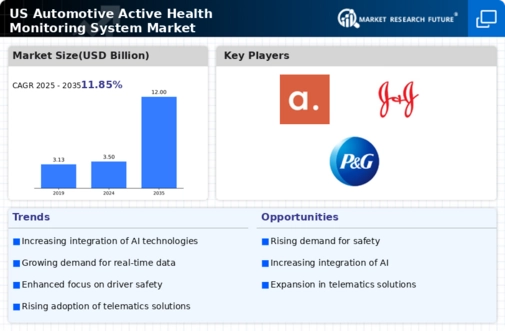Consumer Awareness and Education
Consumer awareness regarding the benefits of health monitoring systems is significantly influencing the automotive active-health-monitoring-system market. Educational campaigns and marketing strategies are effectively informing potential buyers about the advantages of having health monitoring features in vehicles. As consumers become more knowledgeable about how these systems can enhance safety and well-being, demand is likely to increase. This trend is expected to contribute to a market growth rate of around 10% over the next few years. The automotive industry is thus responding by developing more sophisticated health monitoring solutions to meet evolving consumer expectations.
Increased Focus on Driver Well-being
There is a growing emphasis on driver well-being within the automotive active-health-monitoring-system market. As awareness of health issues rises, consumers are seeking vehicles that prioritize their health and safety. This shift in consumer behavior is prompting manufacturers to incorporate health monitoring systems that can detect potential health risks while driving. The market is projected to reach a valuation of $5 billion by 2027, reflecting a compound annual growth rate (CAGR) of 12%. This focus on well-being not only enhances the driving experience but also positions manufacturers favorably in a competitive landscape.
Technological Advancements in Sensors
The automotive active-health-monitoring-system market is experiencing a surge due to rapid advancements in sensor technologies. These innovations enable vehicles to monitor driver health metrics such as heart rate, blood pressure, and fatigue levels in real-time. The integration of high-precision sensors enhances the accuracy of health data collection, which is crucial for timely interventions. As a result, manufacturers are increasingly investing in these technologies, leading to a projected market growth of approximately 15% annually. This trend indicates a strong consumer interest in vehicles equipped with advanced health monitoring capabilities, thereby driving the automotive active-health-monitoring-system market forward.
Rising Incidence of Health-related Driving Incidents
The increasing incidence of health-related driving incidents is propelling the automotive active-health-monitoring-system market. Statistics indicate that approximately 20% of road accidents are attributed to driver health issues, such as sudden medical emergencies. This alarming trend has led to heightened demand for systems that can monitor and alert drivers to potential health risks. Consequently, automotive manufacturers are prioritizing the integration of health monitoring technologies in their vehicles. This proactive approach is expected to reduce accident rates and enhance road safety, thereby driving growth in the automotive active-health-monitoring-system market.
Partnerships and Collaborations in Technology Development
The automotive active-health-monitoring-system market is seeing partnerships and collaborations between automotive manufacturers and technology firms. These alliances aim to leverage expertise in health monitoring technologies, resulting in innovative solutions that enhance vehicle safety. By combining resources and knowledge, companies can accelerate the development of advanced health monitoring systems. This collaborative approach is likely to lead to a more competitive market landscape, with new entrants emerging and existing players enhancing their offerings. As a result, the automotive active-health-monitoring-system market is expected to grow at a robust pace, potentially reaching $6 billion by 2028.














Leave a Comment